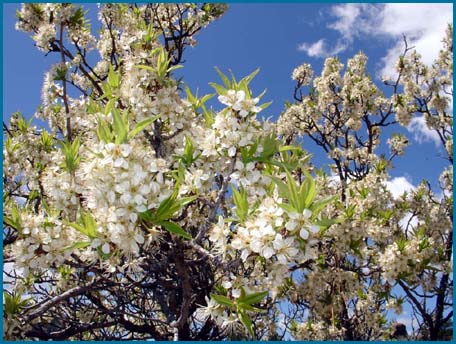The Costs of Raising Sheep & Wool

Wild Plum Blossoms

Wild Plum Blossoms
This is written for all of those of you who have been asking ...
While out on the tractor this past week (again) I had time to think on things. But you must know that if I'm on the tractor, I'm NOT skirting fleeces, I'm NOT washing sheep coats or mending sheep coats, and I'm certainly NOT doing any hand spinning, or dyeing, or weaving.
In fact, the hours spent brush-hogging on the tractor only achieve a few uncertain benefits to the sheep and farm. I'm NOT cutting and baling hay ... we can't do that here on our farm ... there's not enough water to make a hay crop.
What I'm doing is trying to cut the weeds off before they go to seed. This is all of the stuff the sheep won't (can't) eat ... thistles in all of their varieties, pig weeds, lamb's quarter, loco weed (which I try to dig out every May but always miss some) larkspur and as always the mulleins, alyssum, needle grass, and buffalo burrs. Most of these are toxic to the sheep at some time of the year, or just plain unpalatable ... that means nobody anywhere eats them. That "nobody" is the sheep, the deer, the rabbits, and certainly not horses, or cows or goats.
When fields are grazed, you are selecting for all of the things that are NOT eaten ... all of the stuff you really don't want to grow, but there it is, left to do its thing because nobody is bothering it.
The other thing that you may be doing with the brush-hog, is discouraging the parasites that are out in the fields, waiting for the sheep to ingest them. Then there is the possibility that by cutting everything, you have knocked off the terrible grass awns (from the cheat grass) that gets into the sheep's face wool and eyes, and between the dog's toes, and works in and festers into bad infections.
The last benefit is "fire mitigation". Here, where we are part of the Roosevelt National Forest, forest fire is a real and constant threat. We spend our winters cutting the deadwood from the base of the Ponderosa (aka yellow) pines for wood for the wood stove, and summers trying to keep the fields down, so that if/when a fire comes, it will move through rapidly.
Someone lately said they couldn't afford sheep coats for their flock. We certainly couldn't afford to buy their coats. I sew them, wash them, and mend them. Each sheep will need about 6 coats per year (shearing to shearing) ... this allows for the larger coats as the wool grows, and the ones they tear, or just get too dirty to wear anymore.
Coating the flock is this whole other career that is part of my life, if I want to be able to sell top quality wool.
But if I'm working on coats, then I'm I'm NOT skirting fleeces, and I'm certainly NOT doing any hand spinning, or dyeing, or weaving, or brush-hogging, or house-cleaning, or grocery shopping, etc. etc.
Someone else thought that having the sheep wear coats was a cruelty. Trust me, when its 100+degrees and you are a brown, or black, or silver sheep, a clean white coat is a blessing. Especially at our altitude.
Someone else had asked if I shear the sheep myself. No, we pay for that ... upwards of $10 per sheep (including time and travel for the shearer) We sheared some 82 this past Spring, and NO ... I haven't skirted all of the fleeces YET!
We didn't have lambs this past Spring. Last summer was wet at the wrong times. The only hay I could find to buy was put up wet and molded. The ewes will abort on mold, so we decided it wasn't worth that sort of extended health threat for the ewes, and so didn't have a breeding last Fall.
I sure hope the hay crop is better this summer!
Someone else wanted to know how much hay we buy in? For a year its about 1200 to 1400 bales (small bales at 65 pounds each, or about 42 tons, or about $8300 cash)
You can ask Keith about how much fun it is to move that many bales by hand? You can ask me about the daily feedings, twice per day, and how much hay I end up moving?
And then when the sheep are done with the hay, how much volume of bedding and poop we haul out of the barns and pens every week? I'm pretty sure it equals that 42 tons, annually.
Hay ... the gift that keeps on giving!

Burtie as a puppy, March, 2010 |

Burtie as a youngster, July, 2010 ... now 7 months old |
In the past years, since last I wrote a farm newsletter, I've had a good deal of time to think on all of the deaths ... the sheep and dogs that have passed on, as well as family members. My neighbor is fond of saying "if you have livestock, then you also have dead stock". Somehow it doesn't make their passing any easier. I haven't yet learned to "find a response to horror besides despair". I think that may well be my life's task. That, and finding enough hay to feed the flock for another year.
So, when you think about the cost of raising sheep and wool ... and I haven't talked about the vet bills, the straw and mineral bills, the down time and cost to repair the joints of the aging shepherds ... remember also the mental toll on those of us who care deeply about our flocks. No matter how much money I may get for a pound of wool, it never covers all of the expense.
Joanna & Keith Gleason [an error occurred while processing this directive]